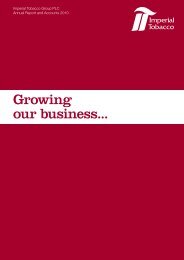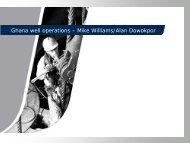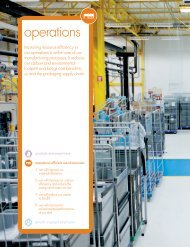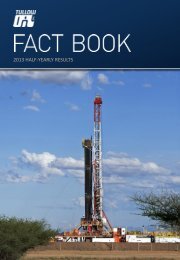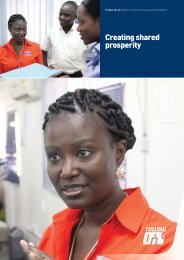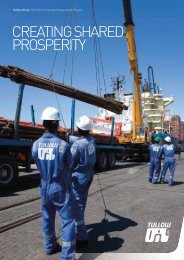Tullow Oil plc Annual Report 2011 - The Group
Tullow Oil plc Annual Report 2011 - The Group
Tullow Oil plc Annual Report 2011 - The Group
- No tags were found...
Create successful ePaper yourself
Turn your PDF publications into a flip-book with our unique Google optimized e-Paper software.
Accounting policies continuedYear ended 31 December <strong>2011</strong>All share-based awards of the <strong>Group</strong> are equity settled asdefined by IFRS 2. <strong>The</strong> fair value of these awards has beendetermined at the date of grant of the award allowing for theeffect of any market-based performance conditions. This fairvalue, adjusted by the <strong>Group</strong>’s estimate of the number ofawards that will eventually vest as a result of non-marketconditions, is expensed uniformly over the vesting period.<strong>The</strong> fair values were calculated using a binomial option pricingmodel with suitable modifications to allow for employeeturnover after vesting and early exercise. Where necessary, thismodel was supplemented with a Monte Carlo model. <strong>The</strong> inputsto the models include: the share price at date of grant; exerciseprice; expected volatility; expected dividends; risk free rate ofinterest; and patterns of exercise of the plan participants.(w) Financial assetsAll financial assets are recognised and derecognised on atrade date where the purchase or sale of a financial asset isunder a contract whose terms require delivery of theinvestment within the timeframe established by the marketconcerned, and are initially measured at fair value, plustransaction costs.Financial assets are classified into the following specifiedcategories: financial assets ‘at fair value through profit or loss’(FVTPL); ‘held-to-maturity’ investments; ‘available-for-sale’(AFS) financial assets; and ‘loans and receivables’. <strong>The</strong>classification depends on the nature and purpose of the financialassets and is determined at the time of initial recognition.(x) Cash and cash equivalentsCash and cash equivalents comprise cash on hand and demanddeposits and other short-term highly liquid investments that arereadily convertible to a known amount of cash and are subject toan insignificant risk of changes in value.(y) Loans and receivablesTrade receivables, loans and other receivables that have fixedor determinable payments that are not quoted in an activemarket are classified as loans and receivables. Loans andreceivables are measured at amortised cost using theeffective interest method, less any impairment. Interestincome is recognised by applying the effective interest rate,except for short-term receivables when the recognition ofinterest would be immaterial.(z) Effective interest method<strong>The</strong> effective interest method is a method of calculating theamortised cost of a financial asset and of allocating interestincome over the relevant period. <strong>The</strong> effective interest rate isthe rate that exactly discounts estimated future cash receipts(including all fees on points paid or received that form anintegral part of the effective interest rate, transaction costsand other premiums or discounts) through the expected lifeof the financial asset, or, where appropriate, a shorter period.Income is recognised on an effective interest basis for debtinstruments other than those financial assets classified asat FVTPL. <strong>The</strong> <strong>Group</strong> chooses not to disclose the effectiveinterest rate for debt instruments that are classified as atfair value through profit or loss.(aa) Financial liabilities and equity instrumentsFinancial liabilities and equity instruments are classifiedaccording to the substance of the contractual arrangementsentered into.(ab) Equity instrumentsAn equity instrument is any contract that evidences a residualinterest in the assets of the group after deducting all ofits liabilities. Equity instruments issued by the <strong>Group</strong> arerecorded at the proceeds received, net of direct issue costs.(ac) Other financial liabilitiesOther financial liabilities, including borrowings, are initiallymeasured at fair value, net of transaction costs. Other financialliabilities are subsequently measured at amortised cost usingthe effective interest method, with interest expense recognisedon an effective yield basis. <strong>The</strong> effective interest method is amethod of calculating the amortised cost of a financial liabilityand of allocating interest expense over the relevant period.<strong>The</strong> effective interest rate is the rate that exactly discountsestimated future cash payments through the expected life ofthe financial liability, or, where appropriate, a shorter period.(ad) Critical accounting judgements and key sources ofestimation uncertaintyDetails of the <strong>Group</strong>’s significant accounting judgements andcritical accounting estimates are set out in these financialstatements and include:Carrying value of intangible exploration and evaluationfixed assets (note 11);Where a project is sufficiently advanced the recoverability ofintangible exploration assets is assessed by comparing thecarrying value to internal and operator estimates of the netpresent value of projects. Intangible exploration assets areinherently judgemental to value and further details on theaccounting policy is included in accounting note (k). <strong>The</strong>amounts for intangible exploration and evaluation assetsrepresent active exploration projects. <strong>The</strong>se amounts willbe written off to the income statement as exploration costsunless commercial reserves are established or thedetermination process is not completed and there areno indications of impairment. <strong>The</strong> outcome of ongoingexploration, and therefore whether the carrying value ofexploration and evaluation assets will ultimately be recovered,is inherently uncertain.Carrying value of property, plant and equipment (note 12);Management perform impairment tests on the <strong>Group</strong>’sproperty, plant and equipment assets at least annually withreference to indicators in IAS 36. Key assumptions in theimpairment models relate to prices that are based on forwardcurves for two years and the long-term corporate assumptionsthereafter and discount rates that are risked to reflectconditions specific to individual assets.122<strong>Tullow</strong> <strong>Oil</strong> <strong>plc</strong> <strong>2011</strong> <strong>Annual</strong> <strong>Report</strong> and Accounts



